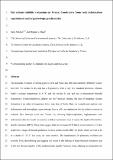Files in this item
Hot climate inhibits volcanism on Venus : constraints from rock deformation experiments and argon isotope geochemistry
Item metadata
| dc.contributor.author | Mikhail, Sami | |
| dc.contributor.author | Heap, Michael J. | |
| dc.date.accessioned | 2018-05-06T23:33:35Z | |
| dc.date.available | 2018-05-06T23:33:35Z | |
| dc.date.issued | 2017-07 | |
| dc.identifier | 249921230 | |
| dc.identifier | 0bc652e0-95a4-4170-a088-624ef66fe896 | |
| dc.identifier | 85019121733 | |
| dc.identifier | 000403522500003 | |
| dc.identifier.citation | Mikhail , S & Heap , M J 2017 , ' Hot climate inhibits volcanism on Venus : constraints from rock deformation experiments and argon isotope geochemistry ' , Physics of the Earth and Planetary Interiors , vol. 268 , pp. 18-34 . https://doi.org/10.1016/j.pepi.2017.05.007 | en |
| dc.identifier.issn | 0031-9201 | |
| dc.identifier.other | ORCID: /0000-0001-5276-0229/work/37274383 | |
| dc.identifier.uri | https://hdl.handle.net/10023/13306 | |
| dc.description | M.J. Heap acknowledges funding from an Initiative d’Excellence (IDEX) “Attractivité” grant (VOLPERM), funded by the University of Strasbourg. | en |
| dc.description.abstract | The disparate evolution of sibling planets Earth and Venus has left them markedly different. Venus’ hot (460 °C) surface is dry and has a hypsometry with a very low standard deviation, whereas Earth’s average temperature is 4 °C and the surface is wet and has a pronounced bimodal hypsometry. Counterintuitively, despite the hot Venusian climate, the rate of intraplate volcano formation is an order of magnitude lower than that of Earth. Here we compile and analyse rock deformation and atmospheric argon isotope data to offer an explanation for the relative contrast in volcanic flux between Earth and Venus. By collating high-temperature, high-pressure rock deformation data for basalt, we provide a failure mechanism map to assess the depth of the brittle–ductile transition (BDT). These data suggest that the Venusian BDT likely exists between 2–12 km depth (for a range of thermal gradients), in stark contrast to the BDT for Earth, which we find to be at a depth of ~25-27 km using the same method. The implications for planetary evolution are twofold. First, downflexing and sagging will result in the sinking of high-elevation structures, due to the low flexural rigidity of the predominantly ductile Venusian crust, offering an explanation for the curious coronae features on the Venusian surface. Second, magma delivery to the surface—the most efficient mechanism for which is flow along fractures (dykes; i.e., brittle deformation)—will be inhibited on Venus. Instead, we infer that magmas must stall and pond in the ductile Venusian crust. If true, a greater proportion of magmatism on Venus should result in intrusion rather than extrusion, relative to Earth. This predicted lower volcanic flux on Venus, relative to Earth, is supported by atmospheric argon isotope data: we argue here that the anomalously unradiogenic present-day atmospheric 40Ar/36Ar ratio for Venus (compared with Earth) must reflect major differences in 40Ar degassing, primarily driven by volcanism. Indeed, these argon data suggest that the volcanic flux on Venus has been three times lower than that on Earth over its 4.56 billion year history. We conclude that Venus’ hot climate inhibits volcanism. | |
| dc.format.extent | 17 | |
| dc.format.extent | 904416 | |
| dc.language.iso | eng | |
| dc.relation.ispartof | Physics of the Earth and Planetary Interiors | en |
| dc.subject | GE Environmental Sciences | en |
| dc.subject | QE Geology | en |
| dc.subject | QB Astronomy | en |
| dc.subject | NDAS | en |
| dc.subject | SDG 13 - Climate Action | en |
| dc.subject.lcc | GE | en |
| dc.subject.lcc | QE | en |
| dc.subject.lcc | QB | en |
| dc.title | Hot climate inhibits volcanism on Venus : constraints from rock deformation experiments and argon isotope geochemistry | en |
| dc.type | Journal article | en |
| dc.contributor.sponsor | The Royal Society | en |
| dc.contributor.institution | University of St Andrews. School of Earth & Environmental Sciences | en |
| dc.contributor.institution | University of St Andrews. St Andrews Centre for Exoplanet Science | en |
| dc.contributor.institution | University of St Andrews. St Andrews Isotope Geochemistry | en |
| dc.identifier.doi | 10.1016/j.pepi.2017.05.007 | |
| dc.description.status | Peer reviewed | en |
| dc.date.embargoedUntil | 2018-05-06 | |
| dc.identifier.grantnumber | RG170224 | en |
This item appears in the following Collection(s)
Items in the St Andrews Research Repository are protected by copyright, with all rights reserved, unless otherwise indicated.

